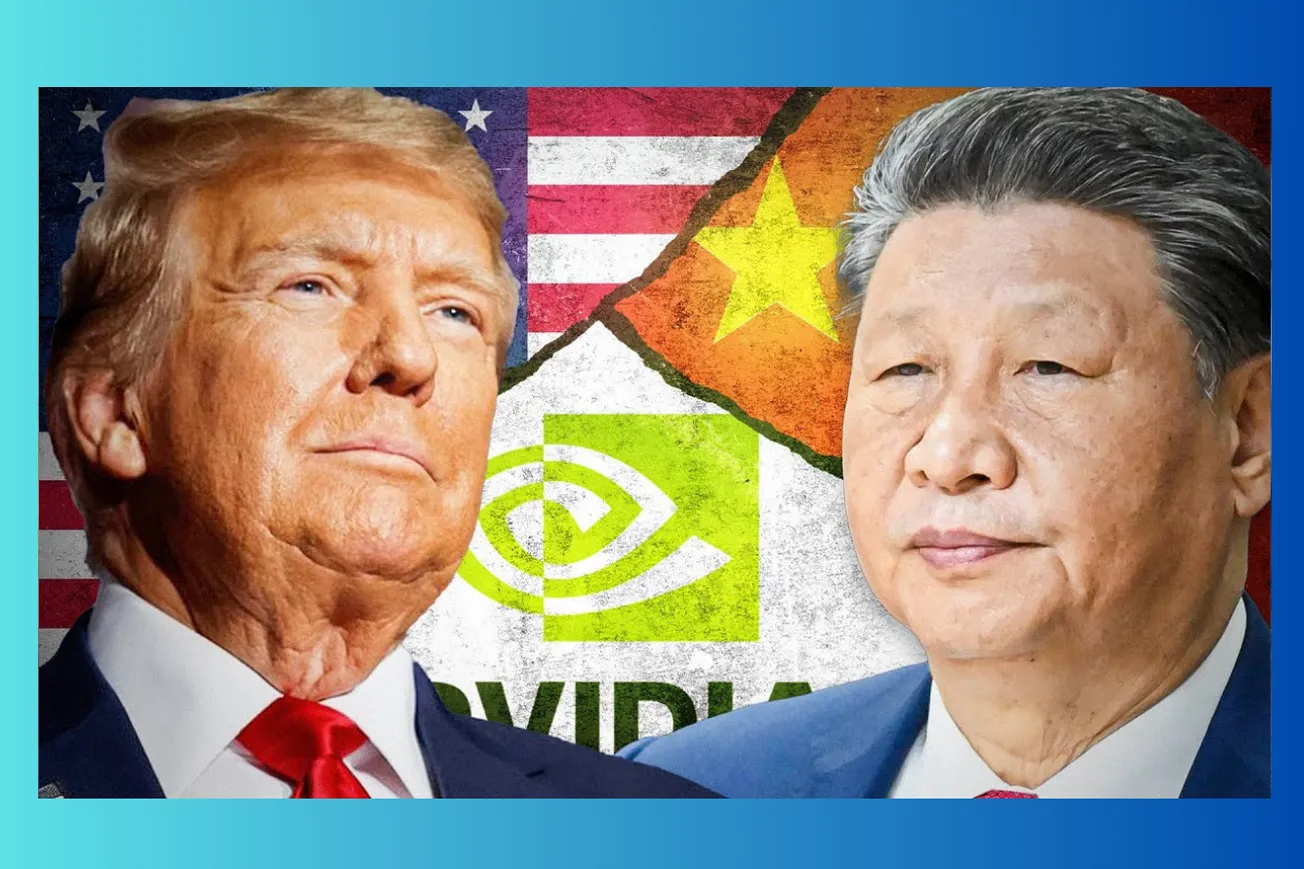Table of Contents
Liberation Day was supposed to mark a new era of American trade dominance. Instead, it may have handed China its biggest opportunity in decades. As Trump declares he's "taking a look at semiconductors and the whole electronic supply chain," the unintended consequences of America's tariff strategy are already reshaping global competition in ways that could permanently damage U.S. technological leadership.
Key Takeaways
- Trump's tariff strategy suffers from conflicting goals—revenge, negotiation, revenue generation, and reshoring manufacturing—making coherent policy impossible
- Liberation Day tariffs on all countries alienated key allies just when collective action against China was becoming possible, shifting global sentiment from "world vs. China" to "world plus China vs. U.S."
- Chinese analog chip companies are experiencing a golden opportunity as tariffs make U.S. competitors like Texas Instruments more expensive right when China unleashes massive new capacity
- The semiconductor tariff structure is incoherent—GPUs face different rates than CPUs, assembly in Mexico gets preferential treatment over U.S. assembly, undermining stated goals
- Enforcement remains the critical weakness—BIS lacks sufficient inspectors to police existing export controls while new restrictions pile up
- Elon Musk's Tesla dependence on China creates internal administration tensions between decouplers and those seeking accommodation
- Companies like Nvidia face impossible choices between Chinese market access and U.S. political favor, with no clear path forward
The Four Competing Goals Problem
Here's what makes Trump's tariff strategy so confusing: it's trying to accomplish four different things simultaneously, and they contradict each other. The first goal is revenge—"getting even for all the people that have taken us to the cleaners for the last 50 years." It's emotional satisfaction disguised as policy.
The second goal is negotiation. The tariffs are supposedly "artfully designed so we don't have to do anything. All we have to do is wait for them to make concessions." If this works, it's brilliant—threaten massive economic pain, then offer to not impose it in exchange for Chinese concessions. But it only works if the threats are credible and you're willing to follow through.
The third goal is revenue generation. The administration needs money to pay for tax cuts, and current estimates suggest tariffs could generate $330 billion annually. That's real money, but it only works if the tariffs stick. If you negotiate them away for goal number two, the revenue disappears.
The fourth goal is the most interesting: bringing manufacturing back to America. "If you make it here, there's no tariff," Trump repeatedly says. But there's an obvious time gap problem. Tariffs go into effect immediately. Building a fab plant takes "lots of money and lots of years." Meanwhile, you're deporting the workers you'd need to staff these new factories.
Which goal takes priority? Nobody knows, and it changes from week to week. This isn't just poor communication—it's genuinely confused policy that makes rational business planning impossible.
Liberation Day: From Isolation to Alliance
Here's what makes the timing particularly tragic. For a brief moment in early 2024, China was genuinely isolated and worried. Chinese semiconductor industry commentary reflected "real fear" and "real trepidation" about U.S. pressure. Beijing understood it was facing potential collective action from the world's advanced economies.
Then came Liberation Day—the decision to impose tariffs not just on China, but on everyone. Overnight, the narrative flipped. As one expert observed: "It's not the world against China anymore, it's the world plus China against the US." Chinese press commentary shifted from worried to optimistic, with some explicitly saying America had "overplayed its hand."
This represents a catastrophic strategic blunder. Countries like India, Turkey, South Africa, Brazil, Canada, and Indonesia were already contemplating tariff actions against China due to overcapacity in steel, aluminum, solar panels, EVs, and other sectors. A coordinated response was becoming possible. Instead, America alienated its potential allies just when they were ready to act collectively.
The Dutch response is particularly telling. During the Biden administration, ASML had given software keys to the NSA to ensure China couldn't use the most advanced EUV lithography tools. After the new tariffs, the Dutch government took the keys back. America went from having unprecedented access to Europe's most critical semiconductor technology to being shut out entirely.
The Semiconductor Tariff Incoherence
The specific structure of semiconductor tariffs reveals just how poorly thought out this policy is. GPUs face different tariff rates than CPUs, which "hurts my brain," as one industry expert put it. If you import GPUs through Mexico as part of a system, you avoid tariffs. Import them directly to the U.S., and you get hit with higher rates.
This creates perverse incentives. Want to do assembly in the U.S.? You've just made that more expensive than doing assembly in Mexico. Want to win the "AI war"? You've just made the whole process more cumbersome and expensive. The policy undermines its own stated objectives.
Meanwhile, the Information Technology Agreement means most semiconductors already enter at zero tariffs. So these new tariffs aren't really about revenge—they're about forcing manufacturing onshore. But the implementation makes domestic manufacturing less competitive, not more.
China's Golden Opportunity in Analog Chips
While everyone focuses on cutting-edge semiconductors, the real action is happening in boring analog chips—the unglamorous components that manage power, process signals, and control basic functions in everything from cars to toasters.
Here's where timing matters enormously. Until recently, the Chinese semiconductor industry was in a "really gloomy headspace." Too much competition, geopolitical constraints, uncertain prospects. Then came the tariffs, making U.S. products from Texas Instruments and Analog Devices much more expensive inside China just as Chinese companies were unleashing "a massive wave of analog capacity."
This is economic warfare in reverse. Instead of constraining Chinese capabilities, we're giving domestic Chinese chip companies a protected market right when they need it most. Once they establish themselves domestically, they'll have the cash flow and scale to compete globally. And once they're competing globally, they'll "wreck a lot of other foreign competitors" because they'll be "very, very cost competitive" with "very low cost of capital."
Texas Instruments spent $10 billion over five years upgrading capacity to compete with Chinese low-cost competitors. They can probably survive the transition. But European companies like STMicroelectronics, Infineon, NXP, and others face a new level of Chinese competition they weren't prepared for.
The Design-Out Acceleration
Export controls were already accelerating Chinese efforts to "design out" American technology from their supply chains. Tariffs are turbocharging this process. Every year, Chinese domestic chip consumption increases by roughly one percentage point. The tariffs will likely create "a big step forward" in the next year.
This matters because once domestic competitors establish themselves, they become permanent fixtures. They get more funding, more cash flow, can do more R&D, become more competitive. It's a virtuous cycle from China's perspective, a vicious cycle from America's.
The policy paradox is striking: we're trying to constrain Chinese technological development while simultaneously creating market conditions that accelerate their independence from American suppliers. It's like trying to starve someone while handing them the tools to grow their own food.
The Enforcement Crisis Nobody Talks About
Here's the dirty secret about export controls: they only work if you have enough people to enforce them. BIS (Bureau of Industry and Security) is chronically understaffed for the mission it's been given. They need "a thousand inspectors" to properly police the existing rules, but they're getting budget cuts instead of increases.
Meanwhile, Chinese companies are playing "constant shell company games, moving around entities" to evade restrictions. Huawei continues finding "new avenues to get TSMC wafers" through an ongoing game of whack-a-mole. Malaysian companies are suddenly building massive data centers with mysterious funding sources.
The federal government is cutting staff across the board, including the IRS agents who might have the financial investigation skills useful for tracking sanctions evasion. At the same time, we're piling new restrictions on top of existing ones that we can't properly enforce. It's a recipe for policy failure.
The Elon Factor and Internal Contradictions
One of the most fascinating aspects of the current administration is the internal tension between different factions. You have decouplers who want nothing to do with China, and you have Elon Musk, whose Tesla fortune depends entirely on the Gigafactory in Shanghai.
Musk faces an impossible situation. Tesla uses Shanghai to export everywhere, competing against 56 Chinese EV companies that would love to see him fail. If he can't deliver a "friendly US-China relationship with all his influence in DC," Chinese competitors will push him out. But if he advocates too strongly for China, he risks Trump's wrath.
Chinese officials were reportedly optimistic about Musk's influence, thinking he would "take care of them." But Trump has a pattern of throwing everyone "under the bus sooner or later." The betting pools in Washington aren't about whether Musk will fall from favor, but when.
This internal contradiction paralyzes coherent policy. How do you maintain technological competition with China while your most prominent tech entrepreneur's business model depends on Chinese cooperation?
Nvidia's Impossible Tightrope
Jensen Huang's recent Beijing visit perfectly illustrates the impossible position American tech companies face. Going to China the day after new AI chip restrictions drop looks tone-deaf. But Nvidia has "some reason to be concerned" about creating market vacuums that Chinese competitors will fill.
There are "20 or 30 GPU companies in China" that aren't particularly good yet but are improving rapidly. Huawei has "some pretty impressive AI chops" and if they can continue accessing TSMC or improve SMIC capabilities, they become "a pretty serious threat to Nvidia."
The policy creates exactly the dynamic we're trying to prevent. Every new wave of sanctions costs Nvidia "a few billion dollars less revenue" while incentivizing Chinese competitors to fill the gap. Once they're established in that market space, "you cannot remove them."
This raises fundamental questions about whether some companies are "too important to punish." If you want to "win the AI contest," you need Nvidia. If you destroy Nvidia through trade restrictions, you lose the very capabilities you're trying to protect.
The Alliance Management Disaster
Perhaps the most damaging aspect of the current approach is how it's destroyed America's credibility as a reliable partner. As one observer noted: "What the United States is basically telling everybody is that we are no longer a reliable partner."
The track record speaks for itself. Trump negotiated USMCA, called it "the greatest trade agreement in history," then started dismantling it five years later. Tariffs are on, then off, then up, then down. There are no exceptions, then exceptions, then postponements, then deadline changes, then deals.
If you were a foreign government, "you'd have no idea what's going to happen next" and wouldn't have "a very high level of confidence that any deal you make is going to stick." This makes collective action against China nearly impossible because potential partners can't trust American commitments.
The contrast with China's approach is stark. Whatever you think of Chinese policies, they're consistent and predictable. Countries know what to expect from Beijing. They have no idea what to expect from Washington, making China look like the stable partner by comparison.
The Memory and Manufacturing Equipment Implications
The tariff effects extend beyond analog chips into memory and manufacturing equipment. Chinese domestic competitors have been "operating for years sort of keeping an eye on" American and European competitors "but not really worried about them." Now they've moved to having "a new bunch of serious competitors" almost overnight.
Companies like STMicroelectronics, Infineon, NXP, Analog Devices, and ON Semiconductor face a fundamentally altered competitive landscape. The "bright spot in analog chip companies' revenues lately" has been Chinese EVs, but those companies will now lose "a big chunk of that market" and have to "lower their outlooks."
There's no easy answer to this challenge. Tariffs aren't working because demand is coming from the Chinese side. Subsidies would be expensive and politically difficult. Consolidation might help some companies but won't solve the fundamental problem of creating protected markets for Chinese competitors.
The Leading Edge Reality Check
While analog and mature node chips face immediate challenges, leading-edge semiconductors remain more secure for now. China "has a ways to go" in terms of advanced manufacturing, though "they're not quite there yet." The constant rumors of breakthroughs haven't materialized into production capabilities that match TSMC or Samsung.
Huawei remains "pretty dependent on TSMC" and continues playing the "constant game of whack-a-mole" to find new avenues for accessing advanced chips. But the tariffs have given Chinese companies "new energy and new confidence" that will "accelerate that process" of technological independence.
The question is timing. Export controls bought time by slowing Chinese development, but tariffs are shortening that window by accelerating their motivation to achieve independence. We may end up dealing with advanced Chinese competitors "a lot quicker than we would have had to deal with it otherwise."
The Revenue Versus Negotiation Paradox
The fundamental tension in tariff policy is that revenue generation and negotiation success are mutually exclusive. If tariffs generate substantial revenue, it's because they're staying in place and trade isn't happening. If negotiation succeeds and China makes concessions, tariffs get reduced or eliminated and revenue disappears.
Current estimates suggest tariffs could generate $330 billion annually—enough to fund significant tax cuts. But that only works if the tariffs stick. If Trump negotiates them away (as he clearly wants to do), the revenue evaporates. You can't have both successful negotiations and substantial tariff revenue.
This creates perverse incentives where the Treasury Department wants tariffs to stay high for revenue reasons while trade negotiators want to reduce them for diplomatic reasons. Without clear prioritization, policy becomes incoherent and counterproductive.
The Manufacturing Timeline Reality
The idea that tariffs will bring manufacturing back to America faces basic timeline problems. Tariffs take effect immediately, imposing costs on consumers and businesses right now. Building semiconductor fabs takes "lots of money and lots of years" with no guarantee of success.
Even if companies commit to American manufacturing, there's a massive gap between when costs hit and when benefits arrive. Meanwhile, the administration is simultaneously deporting workers who might staff these theoretical new factories. The policy pushes companies to reshore production while making it harder to find workers to operate the facilities.
The smarter approach would be carrots rather than sticks—subsidies and incentives rather than punitive tariffs. The CHIPS Act represented exactly this approach, bribing companies to build in America rather than threatening them. But Trump prefers sticks because they're "a lot cheaper for the federal government," even if they're more expensive for everyone else.
The Cat and Mouse Game Continues
For those hoping this represents some fundamental shift in global economic competition, the reality is more mundane. As one longtime Washington veteran observed: "It's been a cat and mouse game for 50 years and that's never going to change."
The enforcement challenges are permanent features, not temporary problems. Chinese companies will always look for ways around restrictions. American companies will always try to maintain market access. The technology will keep evolving faster than regulations can adapt.
The key insight is treating this as "a management problem" rather than seeking "100% effectiveness." If your goal is to ensure Chinese companies "get zero" advanced semiconductors, "you're doomed." But if your goal is to ensure "they only get 25,000 instead of 100,000" and "they all cost five times as much and it takes them 10 years rather than three years," those are "attainable goals."
Looking Forward: The Permanent Damage
The most concerning aspect of current policy is how it's creating permanent competitive disadvantages for American companies. Chinese analog chip makers are getting protected market access right when they need scale. Chinese AI companies are getting incentives to develop domestic alternatives right when they're becoming technically capable.
These aren't temporary dislocations that will correct once trade relationships normalize. Once Chinese companies establish themselves in these markets, they become permanent competitors with lower costs and government backing. The market share they gain during this period won't automatically return to American companies even if tariffs eventually disappear.
We're essentially subsidizing the creation of Chinese competitors while claiming to protect American industry. It's economic policy in reverse, achieving the opposite of stated objectives through poorly designed implementation.
The path forward requires acknowledging that global technology competition is a long-term challenge requiring consistent, predictable policies supported by adequate resources. What we're getting instead is policy chaos that benefits our competitors while harming our allies and our own companies.
The choice ahead is whether to continue this incoherent approach or develop a genuine strategy that aligns means with ends. China is certainly hoping we stick with the current path—it's working out perfectly for them.





